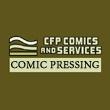CGC at 20 business day Modern turn time?1998
 COLLECTOR COLLECTOR
|
shrewbeer private msg quote post Address this user | |
| Good point Darth, CBCS using PETG plasic was an excellent choice. I actually prefer that a slab be a bulletproof frisbee though. I'd like to see the next generation of slabs to be rock solid (double the wall thickness) and as PETG can easily be manufactured with a UV resistant additive, ADD IT pleeeease  For some reason I thought CBCS was 6yrs old. To your point @Jesse_O , they are doing damn well for only 3yrs at it! |
||
| Post 26 • IP flag post | ||
 Ima gonna steal this and look for some occasion to use it! Ima gonna steal this and look for some occasion to use it!
|
IronMan private msg quote post Address this user | |
Quote:Originally Posted by DarthLego Actually, it is the paper that off-gasses - not the plastic. Newsprint, cardboard, brown kraft type papers are made basically grinding up the entire tree. High quality papers made only from pure cellulose results in a usable yield of about 35%. That can be upped to 95% if lignin from the tree is used. But lignin breaks down more quickly giving off acids and various other chemicals. The reason CBCS does not believe that they need MCP is because their inner well is made of PETG instead of Barex plastic. And PETG isn't quite as strong a gas barrier. Close though. But not as "air tight" as Barex. However, Barex is no longer in production and CGC has also switched to PETG for their inner well. Or so I was told. I put a bunch of time into researching MCP years ago. The tests conducted actually indicated even an open polyester (Mylar) sleeve resulted in similar results to closed. But the tests themselves - accelerated aging tests - were extreme. Paper documents/magazines/books placed in humidity chambers for a few weeks with temperatures in excess of 180 degrees and humidity at 80% or more. AND THEN they added additional pollutants. In that environment, books with MCP came out in better shape than those without. Books in unsealed polyester bags did about as well as sealed. But these are conditions no one would ever come close to storing their slabbed books in. The point of all my rambling here is that the need for MCP is questionable regardless of if in a Mylar, PETG or Barex bag. Sealed or unsealed. When it should be replaced - if ever - is even more a guess. |
||
| Post 27 • IP flag post | ||
 COLLECTOR COLLECTOR
|
shrewbeer private msg quote post Address this user | |
| @IronMan what are your thoughts on sealing a slab airtight? If possible I'd like to see someone offer a slab airtight with a specific inner humidity set. I dont know enough about offgassing and if books need to "air out" because of it though (if so why have we all been locking them in mylar folded/sealed and then all squished together?) | ||
| Post 28 • IP flag post | ||
 Ima gonna steal this and look for some occasion to use it! Ima gonna steal this and look for some occasion to use it!
|
IronMan private msg quote post Address this user | |
Quote:Originally Posted by shrewbeer One thing you ask cannot be done. Humidity is calculated as RELATIVE humidity. In your totally sealed off book, relative humidity would change based on the temperature the book was stored at. As temperature went up the relative humidity would go down. As temperature went down the relative humidity would go up. Ultimately, the best thing collectors can do for long term storage of paper collectibles is the environmental storage conditions. And it turns out that the temperatures and humidity levels that human beings are comfortable in are a good environment for comic books as well. So if your comics - slabbed or raw - are stored in your house in the dark (like say in boxes) and you air condition the place in the summer and heat it in the winter then you are doing quite well. Bags, boards, slabs are more designed to protect books from other external threats. Some bugs eat paper. Mice like to chew them for nesting material. Your ham fisted friends might bend or crease a book looking at it. A splash of water on raw unbagged book is a disaster. Move quickly and even a plastic bag that cost a nickel can save the day. Bags, boards and slabs are all designed to protect your valuable comics from those things. I like the way slabbed books look, I appreciate the widespread acceptance of grade and the professional restoration check. And I am relieved that a slabbed book is stiff enough I can let a non collector friend hold it with no risk of damage to the book inside. |
||
| Post 29 • IP flag post | ||
 COLLECTOR COLLECTOR
|
shrewbeer private msg quote post Address this user | |
| My thought process is this - Foxing is actually organic ( those tan or brown speckles on a book, some very dark) there's a big misconception around this, I've even seen CBCS notes incorrectly call it " rust stains". -That smell when you open a book is mostly organic as well ( not sure if any of that is offgassing though) These things are directly impacted by relative humidity. They grow when it's high and die when it's low. There's also a range in which it cannot survive which overlaps the range in which paper is ideally stored. Given that we are talking about a very small amount of space inside of a slab to begin with, it would be very easy to seal a slab tight and maintain that correct range ( they would just have to print on the label something like "Store between XX-XX temperature". Now if we introduce offgassing into the topic, here's where I go off the rails. Will a book degrade itself due to its own gases over the course of say 50 years if it is not "aired out"? If the answer to that is yes, then we need to look at how we are storing our raw books. If the answer is no, then someone needs to step up and start sealing slabs airtight  My inclination is that the answer is no, loosely based on the fact that CGC was essentially shrink-wrapping books inside cases. |
||
| Post 30 • IP flag post | ||
 Ima gonna steal this and look for some occasion to use it! Ima gonna steal this and look for some occasion to use it!
|
IronMan private msg quote post Address this user | |
| In the field of paper preservation, there are a couple of "gold standards". The most common is to neutralize the acid in paper. This is usually done by spraying onto the paper a neutralizing solution that contains magnesium oxide. Or bathing (immersing) the paper in a bath of such. Spray on products from a variety of companies exist. Wie'To has made such for decades. Bookkeeper is popular too and even places like Bags Unlimited sell it. The problem obviously is you are spraying a liquid onto the paper. It takes practice to not get...poor results like the paper ending up darker in places or get to damp and wrinkle. ALSO - sent to a grading company if detected this is going to result in a restored or more likely conserved label. You've added something to the book. The other "gold standard" I'm aware of is inert gas storage. Deprived of Oxygen, most chemical reactions stop or slow to a craw. This is how the National Archives Museum in Washington, D.C. stores the Declaration of Independence, US Constitution and the Bill of Rights. A titanium framed, bulletproof glass and plastic laminate chamber houses the "Charters of Freedom" in an oxygen free environment. Obviously this method is expensive. While you could no doubt spend less than the several million the National Archives did, it cannot be done on the cheap. Fortunately - as I mentioned earlier - if you'll just not expose your books to light and keep them in a climate controlled environment that is comfortable for human beings - like your house - you are actually doing pretty well by your paper collectibles. |
||
| Post 31 • IP flag post | ||
 COLLECTOR COLLECTOR
|
JWKyle private msg quote post Address this user | |
Quote:Originally Posted by TimBildhauser If I send 20 pre 1975 books that are valued at 100-150 per book not counting any shipping to or from each location. I'm a paid member to CBCS and a 10% discount member at CGC. CGC is $455 CBCS is $540 That a pretty big difference in fees. |
||
| Post 32 • IP flag post | ||
 COLLECTOR COLLECTOR
|
DarthLego private msg quote post Address this user | |
| Someone correct me if I'm wrong, but I believe the off-gassing would degrade the comic paper over time if it was unable to escape the slab or be otherwise absorbed by MCP. | ||
| Post 33 • IP flag post | ||
 COLLECTOR COLLECTOR
|
JWKyle private msg quote post Address this user | |
Quote:Originally Posted by DarthLego I'm looking at a new CGC slab with a inner well. The outer shell of the slab I'm looking at is not air tight. Specifically the top and book seams I can separate with my nail. |
||
| Post 34 • IP flag post | ||
 COLLECTOR COLLECTOR
|
DarthLego private msg quote post Address this user | |
| @JWKyle I was addressing @shrewbeer 's desire to have a company make an air tight bullet proof slab. | ||
| Post 35 • IP flag post | ||
 Ima gonna steal this and look for some occasion to use it! Ima gonna steal this and look for some occasion to use it!
|
IronMan private msg quote post Address this user | |
Quote:Originally Posted by DarthLego Well - that is the theory. That newsprint degrades and off gases over time. And that Microchamber paper traps those organic gas molecules in the paper. Their are several problems with the assumptions and the tests of MCP. To begin with, storage conditions play the most important role in just how fast that breakdown and out gassing takes place. Newsprint was designed to be cheap and disposable. But properly stored it can last a very long time. How long? Hard to say. Newsprint was invented in 1892. But even with newsprint, quality can vary. As a practical matter, one would have to wait 100 years to see what the condition of properly stored comics were in. Not wanting to wait 100 years, researchers develop artificial aging tests. Artificial aging tests are...controversial. Some researchers feel they are deceptive. A few weeks in a humidity chamber at 80-90% humidity, Temperatures at 180 degrees Fahrenheit AND they pump in additional atmospheric pollutants. Obviously those are not conditions that anyone would store their books in. Artificial aging tests show MCP helps preserve the integrity of paper (they do this with folding tests - see how many times the paper can be folded before breaking) But where polyester (Mylar trade name) bags were used, it really didn't matter whether the bags were sealed or opened at the top. The results were pretty much the same. The bottom line I feel is that MCP doesn't do in harm - but it's questionable if it does much good in the environment collectors would keep their books. And since paper stored in even open Mylar sleeves did no better than sealed in the artificial aging tests - using a plastic that is slightly less "air tight" probably doesn't make any difference either. We bag, board, slab our comics to protect them from other things. Handling. Insects, mice, water to name a few. The only practical, cost effective archival storage for most collectors is going to be in a box, in your house. Heat the place in the winter, cool it in the summer. Better methods than that require a change in the way the hobby views restoration/conservation. Paper can be de-acidified. Libraries do it all the time. And libraries do not use MCP for archival storage. They occasionally use it - temporarily - just to help books smell better. But the hobby would have to accept the practice of wetting down the pages of a comic book with a buffering agent and no longer view it as conserved or restored. So right now, just treat your books right. |
||
| Post 36 • IP flag post | ||
 COLLECTOR COLLECTOR
|
shrewbeer private msg quote post Address this user | |
Quote:Originally Posted by DarthLego Yes, so given the discussion at hand and the information we have, I suppose this is what I want: Slabbing is done in an oxygen-free room, set to a relative humidity of 35% @65F. The book is encased in UV filter impregnated .125 wall thickness PETG and sealed airtight.   LMFAO I can wish right?? LMFAO I can wish right?? |
||
| Post 37 • IP flag post | ||
 COLLECTOR COLLECTOR
|
dielinfinite private msg quote post Address this user | |
Quote:Originally Posted by TimBildhauser So it may not say that it should be changed every 7-10 but the site does say that used to be the recommendation |
||
| Post 38 • IP flag post | ||
 Collector Collector
|
Oxbladder private msg quote post Address this user | |
| We can discuss Mylar, MCP, open closed, and so on but the single biggest factor to save the integrity of paper is proper storage environment. If the environment sucks it really doesn't matter what you do. Take a look at the Church pedigree. Stored in large stacks, not bagged and boarded and it was one of the best pedigrees ever discovered. Why? Because they were stored in a good environment. In theory, MCP, like a fully buffered backing board, should be inert once it has absorbed all the gases it can. That is how it was designed. |
||
| Post 39 • IP flag post | ||
 CBCS broke up with me over Facebook. CBCS broke up with me over Facebook.
|
CFP_Comics private msg quote post Address this user | |
Quote:Originally Posted by shrewbeer If you only knew. |
||
| Post 40 • IP flag post | ||
 CBCS broke up with me over Facebook. CBCS broke up with me over Facebook.
|
CFP_Comics private msg quote post Address this user | |
Quote:Originally Posted by Oxbladder As far as MCP is concerned, this is one instance where more may actually be better. I have cracked out many a slab in my career, and I can say there are times that the paper was a specific smell, so it is doing its job. |
||
| Post 41 • IP flag post | ||
 COLLECTOR COLLECTOR
|
shrewbeer private msg quote post Address this user | |
Quote:Originally Posted by CFP_Comics We are wayy off topic on this thread, but please do tell. You've handled more books than most anyone, I'd like to hear your insight on this! |
||
| Post 42 • IP flag post | ||
 I've spent years perfecting my brand of assholery. I've spent years perfecting my brand of assholery.
|
DrWatson private msg quote post Address this user | |
Quote:Originally Posted by CFP_Comics What type of smell? |
||
| Post 43 • IP flag post | ||
 CBCS broke up with me over Facebook. CBCS broke up with me over Facebook.
|
CFP_Comics private msg quote post Address this user | |
Quote:Originally Posted by DrWatson A sour smell. Can't really describe it but it is stronger in books that have been encapsulated longer compared to newer books. |
||
| Post 44 • IP flag post | ||
 I've spent years perfecting my brand of assholery. I've spent years perfecting my brand of assholery.
|
DrWatson private msg quote post Address this user | |
| Like acetic acid? | ||
| Post 45 • IP flag post | ||
 CBCS broke up with me over Facebook. CBCS broke up with me over Facebook.
|
CFP_Comics private msg quote post Address this user | |
Quote:Originally Posted by DrWatsonI don't know what that smells like to compare, but it is a sour smell. |
||
| Post 46 • IP flag post | ||
 COLLECTOR COLLECTOR
|
DarthLego private msg quote post Address this user | |
| @CFP_Comics yes | ||
| Post 47 • IP flag post | ||
 I've spent years perfecting my brand of assholery. I've spent years perfecting my brand of assholery.
|
DrWatson private msg quote post Address this user | |
Quote:Originally Posted by CFP_Comics Vinegar. |
||
| Post 48 • IP flag post | ||
 Collector Collector
|
BradT private msg quote post Address this user | |
| What are the new CGC cases made up of? The older CGC cases and current CBCS cases have a similar feel to me but the newest CGC are much heavier and in my opionion are clearer. | ||
| Post 49 • IP flag post | ||
 COLLECTOR COLLECTOR
|
shrewbeer private msg quote post Address this user | |
| So it seems @DarthLego is correct that a book shouldnt be sealed, as if it is it'll eventually rot in its own gasses. @Oxbladder good point on the Church. The books were in a good environment with plenty of ventilation. Well I'm convinced. Seems CBCS leaving the sides un-sealed is the way to go. |
||
| Post 50 • IP flag post | ||
 Ima gonna steal this and look for some occasion to use it! Ima gonna steal this and look for some occasion to use it!
|
IronMan private msg quote post Address this user | |
Quote:Originally Posted by CFP_Comics Well -- the MCP is doing it's job. The Library of Congress, the Northeast Document Conservation Center and lots of libraries use MCP to absorb odors. Not to conserve or protect the book or magazine from aging. So if you unslab a comic book and the MCP smells funky - it's done it's job. Absorbing odors. That doesn't necessarily mean it kept the paper in better condition. And yes, more may be indeed be better. In the accelerated aging tests I spoke of, the tests speak of "interleaving" MCP into the paper document/magazine/book. Now I have never been able to determine just exactly what "interleaving" means. But I suspect it means more than one or two sheets (modern 1 sheet, older 2 sheets) in a 32-100+ page comic. Chances are interleaving means something like every 4-8 pages. So for MCP to provide protection from aging that the accelerated aging tests it would, a comic book needs to be "interleaved" with MCP. A 32 page comic at least needs three sheets and bigger needs more. To fit the test parameters. |
||
| Post 51 • IP flag post | ||
 Collector Collector
|
mattness private msg quote post Address this user | |
| In my experience of using micro chamber paper, interleaving has always been described as one page per page. If you look at most books in museums you usually see a piece of micro-chamber paper between each page and cover. When the micro-chamber paper begins to offset an odor you replace it with a fresh piece. How long it lasts obviously depends on the materials the item is created with and of course environment. In my personal opinion/experience, the one or two pieces of micro-chamber paper is a marketing device. In a 32 page book two pieces won't last/do much. Proper recommended use of MCP is same size piece of MCP per item as well as one piece of MCP per page, photo or other art. For maximum results there is supposed to be an equal amount of MCP as product. As you can see a couple pages of MCP is not enough for proper care of a full comicbook. | ||
| Post 52 • IP flag post | ||
 COLLECTOR COLLECTOR
|
DarthLego private msg quote post Address this user | |
| I don't think CGC used it as a marketing tool. I think they had legitimate concerns about the plastic they used giving off damaging gasses. | ||
| Post 53 • IP flag post | ||
 Ima gonna steal this and look for some occasion to use it! Ima gonna steal this and look for some occasion to use it!
|
IronMan private msg quote post Address this user | |
Quote:Originally Posted by DarthLego Not the plastic giving off gasses. The NEWSPRINT gives off gases and the sealed, inner plastic well traps those gases. CGC used Barex. Barex is approved by the FDA for packaging medicine, food, beverages. It is a highly effective oxygen barrier and chemically inert - which is why it is approved for packaging medicine. PETG is nearly all those same things. It is the plastic most commonly used by the bottling industry. When you purchase a soda or water in a plastic bottle, you are getting PET or FETG. Obviously it is also and oxygen barrier - if not your soda would be flat. It's just not quite as gas impervious as Barex. Nor does PETG "off gas" any more than Barex. If it wasn't chemically inert it wouldn't be allowed by the FDA to package stuff we eat and drink. PET and PETG are also chemically the same as Mylar - both are polyethylene and Mylar just gets a few extra steps in manufacturing that give it all of it's rigid, super inert and clear properties. I'm sure the grading companies would have just used Mylar from the beginning except it is a great deal more difficult to heat seal shut. The only plant manufacturing Barex plastic has closed. The closure has forced businesses using Barex - including CGC - to look for alternative plastics. So right now it is my understanding that CGC has switched to PETG as well. But CGC still uses MCP. |
||
| Post 54 • IP flag post | ||
 COLLECTOR COLLECTOR
|
DarthLego private msg quote post Address this user | |
| @IronMan Thanks for all that information. |
||
| Post 55 • IP flag post | ||
This topic is archived. Start new topic?
